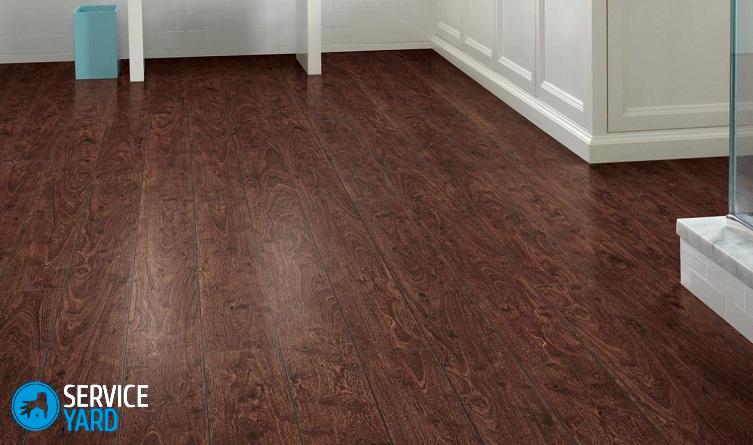Is it possible to lay a laminate on a warm water floor?

Today, the “warm floor” system is no longer a luxury for the elite. It is so popular that it is sometimes used as the main source of space heating. At the same time, many people think: is it possible to lay a laminate on a water floor? Will the flooring be damaged? The question, as they say, is not an idle one, because the laminate is quite sensitive to changes in the indoor climate.
According to experts, the arrangement of a “warm floor” under floor coverings from a parquet or massive board is undesirable. Practice shows that wooden floors in such cases do not behave in the best way. But with the laminate, the story is completely different. The use of this coating in combination with a warm floor has proved to be very good. We will deal with all the nuances.
to contents ↑Material selection
Those who used this coating in the apartment know that no additional insulation helps to keep the laminate cool at any time of the year. Alas, this is not wood, but its surface is just a high-strength organic resin that prevents the abrasion of boards. This resin remains cool in the summer heat and in the winter cold. And if you equip a warm floor under the slats, it will be nice to walk on it even barefoot.
Important! Not all brands of laminate flooring are combined with insulated floors. Cheap varieties of this coating will behave in the same way as wood - they are simply deformed.
Before answering the question, is it possible to make a warm floor under the laminate, you need to choose the right material. Here are the criteria for choosing a floor covering:
- Existence of special marking indicating compatibility of lamellas with heat-insulated floors.
- Thickness of boards is from 8 mm. Lamellas of smaller thickness are deformed by temperature differences.
How to choose the right underfloor heating system?
There are 3 types of systems used for underfloor heating:
- Water.
- Electric.
- Infrared film.
Each of these systems has its own advantages and disadvantages. All of them are approximately equally popular. Let's consider them in more detail.
Water
This is a system of hidden pipes of small cross section, which are connected to the central heating system. Can laminate be laid on a warm water floor? In principle, a water-based floor heating system and laminate flooring are compatible, but exclusively in private homes. In apartment buildings, such systems are prohibited.
This method of floor heating has many disadvantages:
- The complexity and high cost of installation, repair and maintenance.
- When leaks appear in the pipes, it is necessary to change not only the entire pipeline, but also the floor covering. Hot water will render it unusable.
- The complexity of temperature control, and the laminate does not tolerate high temperatures very well.
Cable (electric)
This is the most common option, but, unfortunately, it is not suitable for coatings with low thermal conductivity, including laminate. The reason is that before installing the finish coating, the cable is poured with a screed. Before heating the laminate, the cable must first heat the screed itself. The efficiency of such a system, of course, is small.
Important! The matter is complicated by the fact that a substrate made of a material with low thermal conductivity is laid between the lamellas and the screed. Thus, the floor will heat up slowly with significant energy consumption.
Film
The principle of operation of such a system is based on the phenomenon of infrared radiation. The name “film” system is derived from the thinnest film with mounted conductor strips.
The benefits of film floors include:
- No need for glue and screed.
- Profitability.
- Efficiency for floors made of materials with low thermal conductivity, including laminate.
- Environmental Safety.
Important! Heating the laminate to a temperature exceeding 30 degrees is unacceptable, since the material can be deformed. In addition, heating to high temperatures can trigger the release of formaldehyde.
Output
Thus, the best option is a film infrared system.
to contents ↑Important! Some Western companies produce laminate flooring with an integrated heating system, but it costs a lot.
How to lay a warm floor under the laminate - installation procedure
This is not at all difficult. It is enough to have knowledge of electrical engineering and the desire to make something yourself. Film type underfloor heating are sold as a set:
- Film.
- Contact clamps with insulation.
- Wiring.
In addition, for the arrangement of a film warm floor, you will need:
- A soft base heat reflector that will simultaneously serve as a substrate for the laminate. Do not use materials with aluminum foil.
- Polyethylene (protects the thermofilm from moisture).
- Scotch.
- Thermostat with temperature sensor to control the heating temperature.
How to put a warm floor under the laminate?
- Prepare the surface.
- Place the heat reflector, fastening the joints together with tape.
- Cut the thermal film into strips, lay on top of the heat reflector and secure with tape.
- Mount the thermostat.
- Connect the thermal film strips in parallel using the supplied wires.
- Using bitumen insulation, fasten the sensor on the back of the thermal film.
- Connect the thermostat to the network and test how the system works.
- On top of the mounted system, spread a protective film of polyethylene.
Stock footage
Now you can mount the slats according to conventional technology. Knowing how to make underfloor heating in an apartment under a laminate, you can significantly improve the microclimate in the apartment. But this is an important component of comfortable living conditions.
- How to choose a vacuum cleaner taking into account the characteristics of the house and coatings?
- What to look for when choosing a water delivery
- How to quickly create comfort at home - tips for housewives
- How to choose the perfect TV - useful tips
- What to look for when choosing blinds
- What should be running shoes?
- What useful things can you buy in a hardware store
- Iphone 11 pro max review
- Than iPhone is better than Android smartphones




